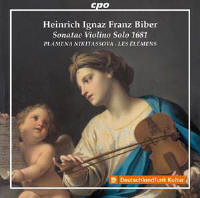Texte paru dans: / Appeared in: |
|
|
Outil de traduction |
|
|
Analyste: Michael De Sapio
In this recording, Plamena Nikitassova elects to hold her Baroque violin, not under her chin, but resting on her shoulder blade, as seen in many old paintings and as described in a few treatises of the period. This must have required considerable retraining, especially for this challenging and exuberant music, and she deserves credit for these efforts. Now, I believe any experiment in authenticity should be judged on its practical results, and I don’t imagine very many listeners will be happy with these. The violinist’s tone is thin and almost willfully unpretty. The ensemble has chosen a very high pitch—about a half step higher than the modern A=440—that renders the violin tone glassy and adds to the strident over-brightness of the interpretation. Some listeners might be discomfited by the unfamiliar pitch, although a variety of pitches were undoubtedly used in Biber’s day and country. The musicians take an extremely freewheeling attitude toward Biber’s already freewheeling scores. Continuo introductions and interludes are added, and the violinist ornaments and improvises profusely around Biber’s notes. (She also either changes or misreads a few notes here and there.) Although the violinist has great agility and dead-on accuracy of finger and bow, the music is not rendered with any kind of affection or lyricism. Everything is flippant, wild, and showy. The spiritual core of these sonatas is missed. There is too much attention-getting gimmickry here, as if Biber was no more than a cheap and eccentric showman. The ensemble, Les Élémens, follows the current vogue for a heavy continuo, in this case consisting of harpsichord, organ, viola da gamba, violone, and theorbo. The sound is overbalanced toward the continuo band, which in some passages forms a loud wall of sound against the violin. The sonatas could just as well be played on only two instruments, violin and organ or harpsichord, and much more effectively in my view. This 1681 set of Biber sonatas for violin and continuo, eight in all, is a real masterpiece that is on a par with, and perhaps even better than, the more famous Rosary Sonatas. John Holloway’s golden edition of the sonatas from EMC featuring organ-and-harpsichord continuo is surely one of the greatest Baroque recordings ever made. Andrew Manze’s version with Romanesca on Harmonia Mundi also has its points. I am baffled why this great series of sonatas has not received more attention on record. Perhaps the Holloway and Manze recordings are of such excellence that they have intimidated any other musicians from essaying the set. Or maybe the lack of a programmatic element in these sonatas has left them in the shadow of the other cycle, which has almost become Biber’s Four Seasons. Yet even if these pieces lack any specified storyline, they are still evocative, dramatic, and profound. Holloway in particular mines the sonatas for all their depth and beauty, and everyone interested in Baroque violin music should hear his recording. For me, this pair of discs is another sign of the new era of Postmodern Baroque which seems to have come upon us. Not only are such performances not, I believe, in keeping with a 17th- or 18th-century spirit, they are not even in keeping with the aesthetic standards of the period-performance movement of a generation ago. They seem to me projections of some strange 21st-century Zeitgeist.
|
|




